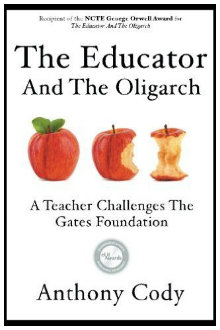Anthony Cody’s Challenge to the Gates Foundation
The Educator and the Oligarch – A Teacher Challenges The Gates Foundation
By Anthony Cody
(Garn Press, 2014 – Learn more)

“In the U.S., the linchpin for education is not teacher effectiveness or data-driven management systems. It is the effects of poverty and racial isolation of our children,” (p. 75).
I have never met Anthony Cody in person. However, we met online in 2010 when we were both members of the core group of organizers for the first Save our Schools (SOS) March in Washington, DC, the summer of 2011.
I was living in Canada at the time but was becoming increasingly concerned with teacher friends’ descriptions of what many were already describing as the privatization and corporatization of schools in the U.S. And I was observing a similar phenomenon starting to happen in certain provinces of Canada.

And Cody’s Books, one of my favorite bookstores on the planet, was owned by Anthony’s parents. Kindred spirits for sure.
In The Educator and the Oligarch Anthony has written an informative, highly referenced book (350 references) that clearly traces the relationship of one of the richest men in the world, Bill Gates, to the gradual privatization of public education in the U.S.
A major conclusion one can draw after reading this book is that Bill Gates, the czar of Microsoft and a career philanthropist, supports the idea that trickle-down economic policies coupled with rigid student testing and teacher evaluation processes will solve the purported crisis of public education in the U.S.
Yes, I know; that’s a mouthful. Nevertheless, it’s important to wrap our heads around this idea if we’re going to successfully turn the tide of misguided corporate reform in public schools.
Cody’s methodical analysis
Anthony methodically and logically sets out to prove that Gates’ interest in public schools is not about improving education for poor or marginalized children. In fact, the Gates Foundation education policies are dismantling public education in the U.S., which is where the bulk of poor and disenfranchised children are educated. This is done by blaming teachers for low student scores on tests that are designed to fail the vast majority of students they claim to champion.
Gates’ solution is to fire ineffective teachers (those whose students don’t perform well on standardized tests), close down schools, and replace them with privately funded charter schools. This may sound like an attractive plan: get rid of ineffective teachers and replace them with upstart young entrepreneurs in often unregulated charter schools and they will perform miracles. Unfortunately, many of these charter schools are for profit and have a reputation of weeding out “undesirable” students and their families.
The bulk of the book distills parts of an online public dialogue between Anthony and education representatives of the Gates’ Foundation. These online, public conversations took place over several weeks and revealed the intransigency of Gates and his foot soldiers to recognize a fundamental truth: the widening gap between rich and poor, as well as the resulting low prospects of rising above the economic conditions of those around you, are major impediments to bridging the learning gap.
As Cody emphasizes, narrowing curriculum to concentrate on increased testing is not what is going to improve the lives of the most disenfranchised in society. Instead, public policies that reduce the gap between rich and poor will go a long way in turning the tide toward real opportunities for our students.
A policy example
One example of the Gates education policy agenda is a major project called Measures of Effective Teaching. This initiative redefines “professionalism for teachers so that it no longer means you have autonomy and responsibility for your work,” (p.14). What other profession would permit continued interference with their work at such levels?
And, Cody argues,
The most deceptive strategy is how they then try to pretend that these indicators are ‘multiple measures’ of good teaching. In fact, these are simply indicators of teaching practices associated with higher test scores” (p.19).
Furthermore, “these tests are ‘insensitive’ to a great deal of learning, and of little use in evaluating the quality of instruction. Therefore, when the Gates Foundation – and its myriad sponsored projects – insist that test data be our guiding star, we are often misled,” (p. 65).
Rather than addressing the more pressing need for effective and long-lasting professional learning experiences for teachers, reformers believe that aligning testing to the curriculum will force teachers to improve. On the other hand, Cody, a former teaching coach in the Oakland (CA) schools, promotes a more holistic approach where teachers focus on their professional learning in the company of their peers (p. 58).
Challenging the myths about public education
Cody also denounces myths about public education promoted by Gates and his supporters that need to be challenged. These are: (1) public schools are failing; (2) charter schools do a better job than public schools and get better results; (3) any problems with standardized tests will be addressed by technical innovations, and (4) teachers are the main reason that students are not doing well.
Cody does a meticulous job of following the money trail set up by these myths, demonstrating who stands to benefit. Of course, as he says,
the fact that someone benefits does not mean their ideas should automatically be dismissed, but we should exercise a far greater degree of skepticism than we now see, and objective evidence should be sought before we accept as truth the latest self-serving demands for ‘courageous action,’ or proclamations of success” (p. 31).
Current efforts at education reform are seemingly focused on shrinking the gap between rich and poor students in schools. However, the lone focus (and pressure) on teachers to close this gap is ill conceived. In fact, Cody notes, “history shows that the greatest closure of the achievement gap took place during the years that the U.S. took concrete steps to economically and racially desegregate schools” (p. 82). The opposite has happened over the last 20 years of school resegregation. Targeting teachers as the culprit for this divide is not only misguided but not supported by historical events.
Why bark up the wrong tree?
So, if we know this to be true, we must ask ourselves why is the Gates Foundation barking up the wrong tree? In chapter 14, “What happens when profits drive reform?,” Cody succinctly answers this question by demonstrating how, over the last two decades and more, public education in the U.S. has been maligned despite the fact that international test results don’t reveal a significant downward shift in scores over time. In fact, the manufactured “crisis of public education” has resulted in many misdirected reform efforts that can be traced to a distinct money trail: charter schools and the privatization of public education.
In part III, chapters 15–21, Cody addresses a variety of technological reforms supported by Gates, which speak to the billionaire’s orientation as an engineer and entrepreneur.
He [Gates] looks at our educational system from the dual lens of an engineer who wants the pieces of this complex system to work together, and from the point of view of a technological entrepreneur, who wants to make the system as open as possible to all sorts of technologically based learning systems,” (p. 108).
This world view translates into the application of technological solutions to perceived education problems, such as computerized high stakes tests. We have already seen the result of this myopic view of the world as teacher evaluations are increasingly tied to student standardized test results with draconian effects.
Gates-styled reforms are “below standard”
In part IV of this book, Cody wants to hold Gates and his foundation accountable for their education reform programs. He lists four standards modeled after the Charlotte Danielson and Robert Marzano teacher evaluation models. After each standard, Cody gives Gates a rating of “below standard.”
The four standards are as follows:
- Standard #1 – Awareness of the Social Conditions Targeted by Philanthropy;
- Standard #2 – Understanding of How Learning is Measured;
- Standard #3 – Understanding of How Teaching is Evaluated; and
- Standard #4 – Understanding of Effective Instruction.
Cody is generous enough to offer Gates “recommendations for professional growth” under each standard.
The Educator and the Oligarch goes to great pains to unmask the less than altruistic motivations behind the initiatives promoted by the Gates Foundation. Events like the SOS March this summer are a testament that the tide is turning; teachers, parents and students are taking back our public schools from non-educators. Thank you, Anthony Cody, for writing this book and spurring on this movement.
Elisa Waingort has been teaching in bilingual settings for more than 30 years in public and international schools in North and South America and has long been active in leadership roles in the National Council of Teachers of English (NCTE). She is currently teaching grade 5 at Academia Cotopaxi, an American International School in Quito, Ecuador. Elisa blogs at A Teacher’s Ruminations. Her professional and classroom Twitter handles are @elisaw5 and @mselisacoto, respectively. Read her recent article on international teaching here at MiddleWeb.































